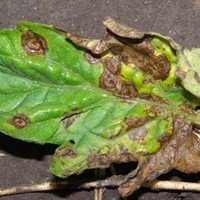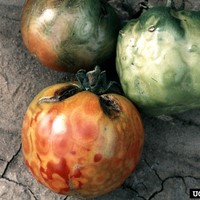
Tomatoes: What to do Now for Luscious Tomatoes This Summer
Tomatoes are one of the most home-grown crop; probably because there is nothing like that big bite or slice of that juicy, delicious red ball. But many enthusiastic home gardeners find themselves frustrated or disappointed in their tomato crop. This article explains gardening practices that you can adopt to increase the chances of producing happy, healthy tomato plants in your yard.
Michelle Scullard, Dakota County Master Gardener

Many people eagerly await that first bite of homegrown tomatoes every summer. And that first succulent bite is achieved by the work you do now, early in the summer. First, it is not too late to plant tomatoes, but at this point, you will need to purchase plants if you did not start your own. Whether you choose an heirloom or a modern variety (often bred to decrease susceptibility to disease and other unfavorable traits) is a personal preference. One approach to choosing might be to get a variety you have grown before and a variety new to you.
Some other characteristics you may want to consider relate to the disease resistance of the tomato plant. Plants marked with “F, FF, FFF” are resistant to fusarium diseases, while a “V” indicates resistance to Verticillium Wilt. A plant marked with “VF” is resistant to fusarium and verticillium wilts. A plant labeled with “EB” is resistant to Early Blight. If you choose a tomato that does not indicate that it has been developed with resistance to different tomato diseases, you’ll want to implement some good, basic gardening practices to decrease the risk of losing your tomato crop.
Choose a tomato with a sturdy stem that is at least a pencil width. Make sure there are no spotted leaves as that may be an indicator of disease. Leaves should be spaced closely together. There are two main types of tomatoes; determinate and indeterminate. Determinate tomatoes are bushy and generally do not need pruning, staking, or trellising. The top, also called terminal point, ends with flowers and fruit. They grow to about 24 – 30 inches tall and produce fruits within a 4 to 6-week period. They may be best for container grown tomatoes.

Most tomato plants are Indeterminate and they are vining. They do need support to keep their leaves and tomatoes off the ground, allow for air flow, and reduce the risk of diseases. The terminal point keeps growing as the plant grows. Tomatoes grow along the branches, and they will produce fruit until it gets too cold. Stake or trellis plants immediately when you plant them.

Good tomato gardening practices start with ensuring good soil. You want rich loamy soil that drains well. If you don’t know what kind of soil, you can do a soil test from the University of Minnesota and add amendments such as fertilizer or other missing nutrients. The next critical step is to not plant your tomatoes in the same place every year. You need to rotate them to different areas in your garden, if at all possible. This helps decrease the threat of diseases that remain in the soil. It is recommended to wait three to four years before planting tomatoes again in that spot. Make sure you space your tomatoes a sufficient distance apart. You can find that information on the seed package or the plant tag. Dig a hole deep enough to place the whole container part of the plant and remove lower leaves and branches so they aren’t touching the soil. If you have a slightly crooked plant, you can actually dig the hole even deeper so the above ground part is the straight part. The tomato will actually grow roots from the stem that is underground.
Consistent watering is critical to prevent “blossom end rot” (where the tomato has a black bottom), as is an adequate amount of calcium. You can find products in the store that you may want to periodically add throughout the season. When you water your tomatoes, make sure to water at the base of the plant and not overhead. This reduces disease risk on the leaves and prevents water splashing from the soil onto the plant, which is another source of tomato diseases. You will want to water deeply to help promote deep rooted plants. Generally, one inch a week is recommended but you may need to water more frequently if it is very hot and dry, or your tomato is in a container. Sandy soils will require more frequent watering, too.
Despite your best efforts, you may still find diseases impacting your tomato plants and your tomatoes. Early blight, tomato viruses, bacterial spot, and late blight are some of the diseases that plague many Minnesota tomato growers due to Minnesota’s climate. To learn more about each of these diseases and how you can recognize them on your tomato plants, you can learn more here: Tomato Diseases.
In addition to tomato diseases, you will need to watch for insects that may impact your tomato harvest. Insects to be aware of include: cutworms, flea beetles, Colorado potato beetle, aphids, sap beetles, and tomato hornworms (for more information, start here: Insects and Tomato Plants)
Finally, some common problems you may experience and may have little ability to prevent are: blossom end rot, growth cracks (fruit grows too quickly), catfacing (many causes), leaf roll, sunscald (tomato fruit gets too much sun), and yellow shoulders (top never ripens). You can find more information on these disorders here: Tomato disorders

Tomatoes are not hard to grow but do require some specific gardening practices to ensure you can get a lot of fruit that are healthy and tasty. And most gardeners will agree that they are worth all the effort!
Reference:
University of Minnesota Extension Gardening
Growing Tomatoes in Home Gardens
Photo credits: UMN Extension (1-5), University of Wisconsin Madison Extension (6)





